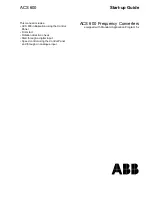
SINAMICS G120D
List Manual (LH14), 01/2016, A5E33842313
903
4 Faults and alarms
4.2 List of faults and alarms
For fault value = 9, 10:
- the measurement was carried out at an operating point where the load torque is too high. Select a more suitable
operating point, either by changing the speed setpoint (p1961) or by reducing the load torque. The load torque may
not be varied while making measurements.
Note:
The saturation characteristic identification routine can be disabled using p1959.1.
See also: p1959 (Rotating measurement configuration)
F07984
Drive: Speed controller optimization, moment of inertia
Message class:
Error in the parameterization / configuration / commissioning procedure (18)
Reaction:
OFF1 (NONE, OFF2)
Acknowledge:
IMMEDIATELY
Cause:
A fault has occurred while identifying the moment of inertia.
Fault value (r0949, interpret decimal):
1: The speed did not reach a steady-state condition.
2: The speed setpoint was not able to be approached as the minimum limiting is active.
3. The speed setpoint was not able to be approached as the suppression (skip) bandwidth is active.
4. The speed setpoint was not able to be approached as the maximum limiting is active.
5: It is not possible to increase the speed by 10% as the minimum limiting is active.
6: It is not possible to increase the speed by 10% as the suppression (skip) bandwidth is active.
7: It is not possible to increase the speed by 10% as the maximum limiting is active.
8: The torque difference after the speed setpoint step is too low in order to be able to still reliably identify the moment
of inertia.
9: Too few data to be able to reliably identify the moment of inertia.
10: After the setpoint step, the speed either changed too little or in the incorrect direction.
11: The identified moment of inertia is not plausible. The measured moment of inertia is less than the 0.1x or greater
than 500x the preset moment of inertia of the motor p0341.
Remedy:
For fault value = 1:
- check the motor parameters (rating plate data). After the change: Calculate p0340 = 3.
- check the moment of inertia (p0341, p0342). After the change: Calculate p0340 = 3.
- carry out a motor data identification routine (p1910).
- if required, reduce the dynamic factor (p1967 < 25 %).
For fault value = 2, 5:
- adapt the speed setpoint (p1965) or adapt the minimum limit (p1080).
For fault value = 3, 6:
- adapt the speed setpoint (p1965) or suppression (skip) bandwidths (p1091 ... p1094, p1101).
For fault value = 4, 7:
- adapt the speed setpoint (p1965) or maximum limit (p1082, p1083 and p1086).
For fault value = 8:
- the total drive moment of inertia is far higher than that of the motor (refer to p0341, p0342). De-select rotating
measurement (p1960), enter the moment of inertia p0342, re-calculate the speed controller p0340 = 4 and repeat the
measurement.
For fault value = 9:
- check the moment of inertia (p0341, p0342). After the change, re-calculate (p0340 = 3 or 4).
For fault value = 10:
- check the moment of inertia (p0341, p0342). After the change: Calculate p0340 = 3.
For fault value = 11:
- reduce the moment of inertia of the motor p0341 (e.g., factor of 0.2) or increase (e.g. factor of 5) and repeat the
measurement.
Note:
The moment of inertia identification routine can be disabled using p1959.2.
See also: p1959 (Rotating measurement configuration)
















































